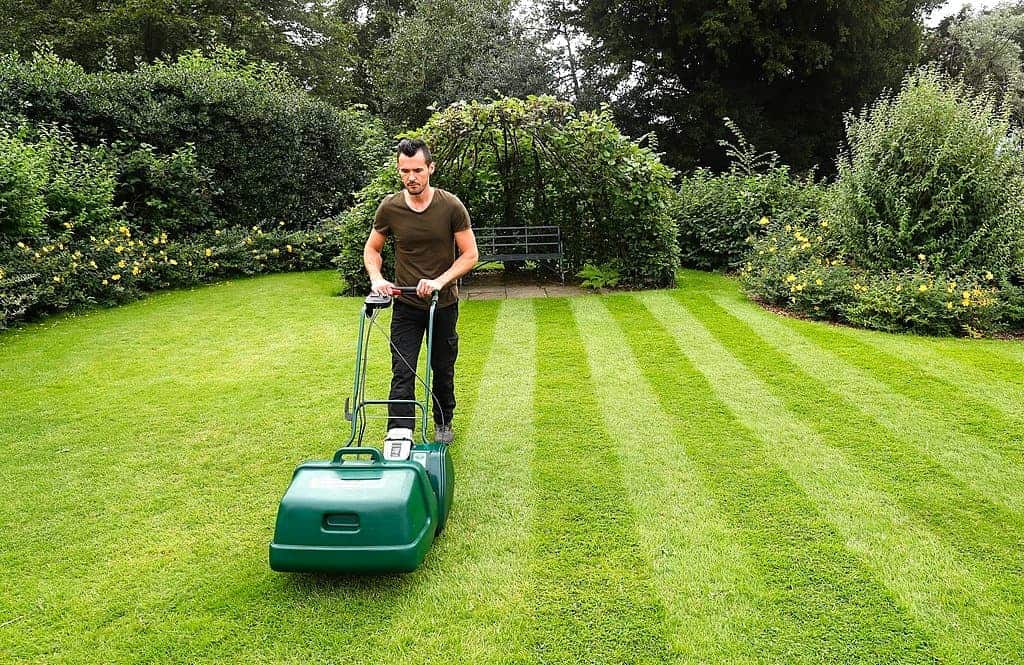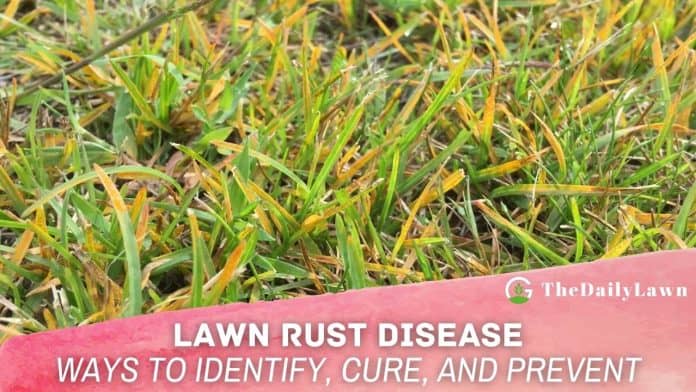If you start talking about the most common and irritating lawn diseases, I am sure that you have to keep the lawn rust disease at the top of the list. In European and American provinces, this disease has become prevalent due to the weather that causes extra moisture on the lawn soil.
Basically, the rust on the grass leaves results from fungus infection and can spread rapidly if you don’t take care of it from the beginning. However, identifying the rust disease is another challenging task as well. It looks similar to the dry patches on the lawn, which many people consider sunburn.
If you are concerned about your lawn, I think you should spend a few minutes learning about this common lawn disease. If you agree with me, I am sure this content will come as a great help. From its nuts to the bolts, I will try to cover everything about the disease here in one place. So, skip it at your own risk.
What Is Lawn Rust Disease?

When the environment is hot and lacks enough moisture, the rust fungus can attack your lawn grass, but it is not the main reason. Also, many people find them at the time of dusty weather and when the grass lacks nitrogen. So, insufficient appropriate fertilizer for the lawn is a significant reason for this disease.
Though lawn rust spreads rapidly through its spores, generally, it is not always required to use fungicides on it. Also, extra moisture can be responsible for this disease, not just the dry season. Besides, not just your lawn grass; if you have a garden, you will find the same condition on the leaves of different plants.
How to Identify Lawn Rust Disease?

You can simply pull off a few blades from the turf if you see symptoms of this unpleasant disease on grass. In the beginning, it makes the yellowish brown affected area in the leaves. Gradually, it changes color and finally turns into an orange, red, or deep brown color. The entire leaf will change color and then die.
Generally, the spores of this fungus live on the tip of the grass. Consequently, they started to spread and finally affected the entire grass area. A finger can rub off the spores of this rust disease. But that is not the best way to kill it.
Commonly, this disease affects many different types of lawn grass. From ornamental plants to evergreens, all the green areas might be covered by rust problems. Eventually, it can cover the entire lawn and leave a dead lawn if you don’t take care of it from the beginning.
Causes of Lawn Rust Disease

If the grasses don’t get enough sun exposure and can’t dry out in 6 to 8 hours, they can be susceptible to rust fungus. Damp or extra moisture allows the fungal infections to grow. Low lights, shades, or shorter days can be a trigger to this problem.
Even moist weather is another reason which encourages this problem. If the temperature is 70 degrees F with a high dew point, rust on the grass will come off easily. Excessive thatch is also a hindrance to getting rust-free grass. And also, it is rare, but the too much drier season can be a cause of this disease as well.
How to Treat Rust Disease Affected Grasses?

- If an area of your lawn is entirely affected by rust disease, try to change the turf grass and prefer a more resistant grass type.
- You have to use fertilizers if it is the beginning condition. A fertilizer rich in nitrogen can help control this disease.
- Make sure to test the soil on your lawn before you choose a fertilizer.
- It will help if you try fertilizer in Fall. The fertilizer you use will start working in winter and will save your lawn from different diseases.
- Make sure to cut the affected grasses as soon as you find them. Try to use a spade or knife to cut them. A mower can spread the spores, and that can be more dangerous.
- Try to ensure enough sun exposure to the affected area. With solar heat, the affected area can get healed.
- After removing all the affected grasses, you have to rinse the area properly. Water will wash off the fungus.
These are the common tricks you can follow to get rid of lawn rust disease. Here, you can use fungicides if the affected area is immense. But make sure to use it before you cut the grass that is affected. Also, you should wait for a few days after applying the fungicides to let it work.
How to Prevent Grass Rust Diseases?
Many seasonal and fungal diseases can cause severe damage to your lawn. And rust disease typically attacks the weak grass after draught. You can prevent grass rust disease just by following some easy tasks. Check out and get acquainted with them in the following section.
1. Aerate Your Lawn Timely

These holes in the soil give proper ventilation, nutrient management, moisture control, and much more. You can use special aeration tools or garden forks to make these holes which would help to hold water and air and penetrate the soil.
Unlike other fungal diseases, this rust disease takes place on the live grass, which is prevalent in and after draught season. Aeration can help remove the possibility of this grass disease and also improve the drainage system significantly.
2. Improve Airflow and Sun Exposure
Another way to prevent grass rust disease is to provide adequate sunlight and airflow. This may sound like easy work but not always, as this greatly depends on your place and the location of the lawn. Your nearby buildings, big trees, and other immovable structures can sometimes cast shade and even block positive airflow.
You can remove any structure that is providing unwanted shade on the lawn, such as hanging beaches of a tree. These type of low branches blocks light and air. The branches that are above 3 feet from the floor level are good. Brunches lower than that should be cut. Another proceed is pruning hedges and large thick bushes. By doing so, more air and light will pass through.
Additionally, you can replace the fencing system for optimal light and air passage to the lawn. It could be tiring but a must-do if removing share sources and eradicating bushes do not work. Replacement of the solid fence panel would lessen the moisture on the surface and promote the health condition of the weak lawn.
3. Mow the Lawn

The most important way to keep the lawn grass healthy is to cut them regularly. Keep in mind that grass leaves and roots trap the sunlight and utilize the energy to produce food and store them for long periods. So, it is better to have dense and keep the grass heigh short. This makes lawns more healthy and resistant to potential diseases like grass rust disease.
4. Water in the Hot Weather
You must regularly water the lawn in warm weather; it is a very simple task, yet most people do it wrong. Most lawn owners water their lawn in the evening using a garden hose which is vastly problematic on its own. First of all, this leaves the water on the grass, not the soil. But, grass or leaves does not utilize water; it requires the water to get into the soil and roots.
If you want to see your lawn healthy and avoid rust diseases, you should water the lawn as much as 1-2 inches of rain in a week. This is quite a lot if you have a large lawn area. You should water the lawn in the morning and let it soak in the sunlight for optimal results. This will help the lawn grass grow and prevent diseases like lawn rust, pink patch, and other ground-based fungal infections.
If you water at night or evening, the soil will remain damp, and surface moisture will stay in the ground the whole night. This is more than enough for fungus to breed and donate to the area.
So, you should water the lawn adequately at least once a day a week; it will take an hour or more. To measure the water, you can put a tray or bowl on the lawn while watering. If it goes over 2 inches, you should stop watering.
5. Apply Fertilizers

Then, you should apply a nitrogen-enriched autumn fertilizer as required in the autumn. Don’t apply too much and try to avoid liquid fertilizers in drought conditions, as they could scorch the grass and hamper the lawn’s growth. Keep in mind that you must keep the nitrogen levels of the lawn’s soil to the peak level to prevent grass rust disease. In low to moderately warm weather, you can use nitrogen-rich liquid fertilizers.
FAQ
Q: Does rust disease go away from the lawn on its own?
A: Most of the time, lawn rust disease doesn’t go away on its own. It needs proper treatment and enough sun exposure to heal. It appears mostly on moisture and weak grass. So, the grasses need to be healthy with the right fertilizers.
Q: Why does rust disease appear on my lawn?
A: Rust disease is a fungal infection and primarily affects the weak grasses on your lawn. It appears because of different reasons, including extra moisture, insufficiency of nitrogen, no sun exposure, drought, and so on.
Q: How does the rust-affected grass look?
A: Generally, the rust disease-affected grass looks like yellowish-brown spots on the grass in the beginning. Gradually, when the fungus on the grass is mature, the grass turns into dark brown color.
Q: Does Nitrogen fertilizer help to cure rust disease?
A: Yes, nitrogen-rich fertilizer must help your lawn cure rust disease. In this case, you better test the soil and select the right lawn fertilizer with the appropriate amount of nitrogen.
Q: Is lawn rust disease harmful to pets?
A: No, lawn rust disease is not harmful to pets. The fungus can only live on plants like grass. But they cannot live on other inhabitants. However, this disease is only harmful to your lawn as they just kill the grasses.
Final Verdict
Always remember that lawn rust disease is not a joke. And you should always check your lawn correctly so that you can identify the disease in its early stage. It will then be helpful to cure the disease properly. You must know the symptoms now so that you can identify them easily. But make sure not to be confused and take it as sunburn.
However, it will be best if you try the prevention methods before it attacks your lawn. The ways are simple, and you just have to maintain a daily and proper routine for your lawn. Besides, you should aerate the lawn timely and mow it before the grass gets longer.
Hopefully, you have understood all the points correctly. So, please be serious about the lawn rust disease before it gets too late. You can also knock us in the comment section if you have any questions regarding this fact. Thank you for your time.
